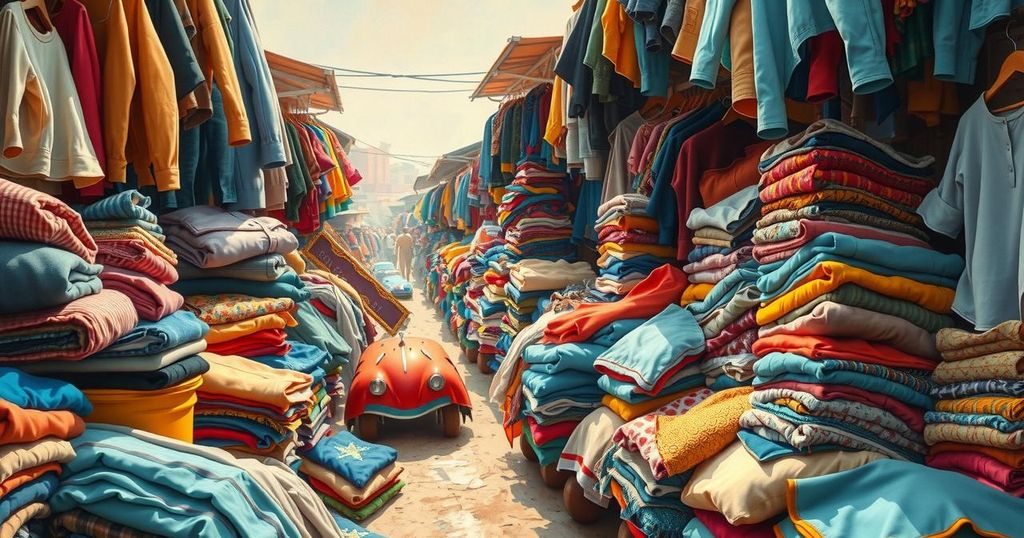Policy Shifts and Demand Propel Kenya’s Expanding Mitumba Market

Kenya has emerged as Africa’s leading importer of second-hand clothing, known as mitumba, importing $298 million worth in 2023. Increased demand for affordable apparel, driven by policy changes such as tax removals, has intensified competition with the struggling local textile industry. The ongoing debate around mitumba reflects contrasting perspectives on economic accessibility and domestic textile production challenges.
Recent data from the Massachusetts Institute of Technology (MIT) indicates that Kenya has emerged as Africa’s largest importer of second-hand clothing, known locally as mitumba, with imports valued at $298 million (approximately Sh38.5 billion) in 2023. This figure marks a significant increase from the $265 million (Sh34.28 billion) imported in 2022, illustrating the growing domestic demand for affordable clothing despite the challenges faced by Kenya’s textile industry.
The rise in mitumba imports is attributed to an increased demand for inexpensive apparel, with various second-hand items such as underwear, trousers, dresses, jackets, shoes, and household textiles being imported. Unlike neighboring nations, Kenya continues to allow large volumes of these used clothing items into its market, as Uganda, Rwanda, and Ethiopia have opted for restrictions to foster local textile production.
The surge in imports has been bolstered by recent policy changes, specifically the removal of the Import Declaration Fees (IDF) and Railway Development Levy (RDL), making mitumba imports more cost-effective. Although this decision aimed to stimulate trade, it has drawn criticism from domestic manufacturers who argue that this undermines local textile efforts and further intensifies competition from inexpensive second-hand clothing.
Despite stringent measures adopted by other East African Community (EAC) countries, such as increased tariffs and higher import duties aimed at protecting local industries, Kenya’s open approach has raised concerns regarding potential smuggling activities. Officials suggest that a number of mitumba imports may be transiting to other nations, complicating regulatory efforts.
The implications of Kenya’s participation in the African Growth and Opportunity Act (AGOA) further necessitate maintaining a favorable environment for mitumba imports. This agreement permits duty-free access for African nations’ textile exports to the U.S. However, the continued accessibility of second-hand clothing is essential for Kenya to retain its AGOA privileges, as demonstrated by neighboring countries’ removals from the act after imposing bans on mitumba.
The conversation surrounding Kenya’s second-hand clothing trade is highly polarizing, where proponents view it as essential for low-income communities while critics argue it hinders the local textile sector’s growth. The textile industry, despite its capacity to generate employment, has encountered persistent struggles over years due to various unfulfilled governmental initiatives aimed at revitalization.
The contentious topic of mitumba imports was especially highlighted during the last general election, where former Prime Minister Raila Odinga faced backlash following comments favoring a shift to local textile production, leading to an uproar among traders reliant on mitumba. Current administration leaders have utilized this discourse to gain support from the mitumba trader community.
Recent government initiatives aimed at revitalizing the textile sector include the modernization of the Rivatex East Africa factory in Eldoret, which has received substantial funding for upgrades to enhance production capabilities. Additionally, the National Cotton, Textile, and Apparel (CTA) Policy 2024 has been introduced to bolster local cotton farmers while improving the textile value chain with strategic investments and development plans for textile facilities and ginneries across Kenya.
In summary, Kenya’s mitumba market is experiencing significant growth driven by heightened demand and recent policy adjustments favoring imports. While the surge presents an economic opportunity for affordable clothing access, it simultaneously poses challenges for the domestic textile industry. The ongoing debate over the implications of second-hand clothing imports continues to divide policymakers, thereby underscoring the need for balanced strategies that can support both local production and consumer affordability.
Original Source: eastleighvoice.co.ke








